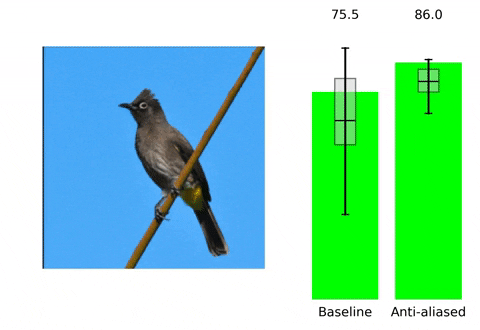Antialiased CNNs [Project Page] [Paper] [Talk]
Making Convolutional Networks Shift-Invariant Again
Richard Zhang. In ICML, 2019.
Run pip install antialiased-cnns
import antialiased_cnns
model = antialiased_cnns.resnet50(pretrained=True) Now you are antialiased! If you want to antialias your own model, use the BlurPool layer.
C = 10 # example feature channel size
blurpool = antialiased_cnns.BlurPool(C, filt_size=4, stride=2) # BlurPool layer; use to downsample a feature map
ex_tens = torch.Tensor(1,C,128,128)
print blurpool(ex_tens).shape # 1xCx64x64 tensorMore information about our provided models and how to use BlurPool is below.
Update (Sept 2020) You can also now pip install antialiased-cnns and load models with the pretrained=True flag. I have added kernel size 4 experiments. When downsampling an even sized feature map (e.g., a 128x128-->64x64), this is actually the correct size to use to keep the indices from drifting.
- More information about antialiased models
- Instructions for antialiasing your own model, using the
BlurPoollayer - ImageNet training and evaluation code. Achieving better consistency, while maintaining or improving accuracy, is an open problem. Help improve the results!
Pip install this package
pip install antialiased-cnns
Or clone this repository and install requirements (notably, PyTorch)
https://github.com/adobe/antialiased-cnns.git
cd antialiased-cnns
pip install -r requirements.txtThe following loads a pretrained antialiased model, perhaps as a backbone for your application.
import antialiased_cnns
model = antialiased_cnns.resnet50(pretrained=True, filter_size=4)We also provide weights for antialiased AlexNet, VGG16(bn), Resnet18,34,50,101, Densenet121, and MobileNetv2 (see example_usage.py).
The antialiased_cnns module contains the BlurPool class, which does blur+subsampling. Run pip install antialiased-cnns or copy the antialiased_cnns subdirectory.
The methodology is simple -- first evaluate with stride 1, and then use our BlurPool layer (also referred to as BlurPool) to do antialiased downsampling. Make the following architectural changes to antialias your strided layers. Typically, blur kernel M is 4.
import antialiased_cnns
# MaxPool --> MaxBlurPool
baseline = nn.MaxPool2d(kernel_size=2, stride=2)
antialiased = [nn.MaxPool2d(kernel_size=2, stride=1),
antialiased_cnns.BlurPool(C, filt_size=M, stride=2)]
# Conv --> ConvBlurPool
baseline = [nn.Conv2d(Cin, C, kernel_size=3, stride=2, padding=1),
nn.ReLU(inplace=True)]
antialiased = [nn.Conv2d(Cin, C, kernel_size=3, stride=1, padding=1),
nn.ReLU(inplace=True),
antialiased_cnns.BlurPool(C, filt_size=M, stride=2)]
# AvgPool --> BlurPool
baseline = nn.AvgPool2d(kernel_size=2, stride=2)
antialiased = antialiased_cnns.BlurPool(C, filt_size=M, stride=2)We assume incoming tensor has C channels. Computing a layer at stride 1 instead of stride 2 adds memory and run-time. As such, we typically skip antialiasing at the highest-resolution (early in the network), to prevent large increases.
To reduce clutter, this is linked here. Help improve the results!
This work is licensed under a Creative Commons Attribution-NonCommercial-ShareAlike 4.0 International License.
All material is made available under Creative Commons BY-NC-SA 4.0 license by Adobe Inc. You can use, redistribute, and adapt the material for non-commercial purposes, as long as you give appropriate credit by citing our paper and indicating any changes that you've made.
The repository builds off the PyTorch examples repository and torchvision models repository. These are BSD-style licensed.
If you find this useful for your research, please consider citing this bibtex. Please contact Richard Zhang <rizhang at adobe dot com> with any comments or feedback.


